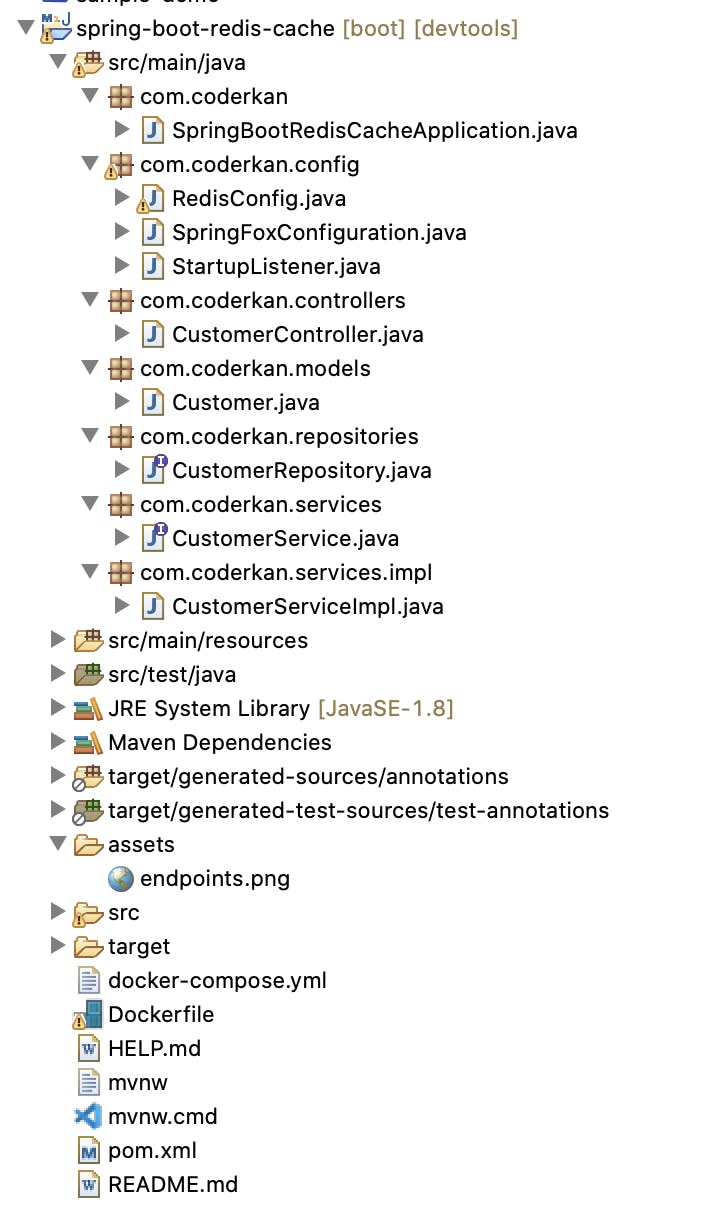Photo by Markus Spiske on Unsplash
Hi everyone,
In this post, I would like to show you how to use Redis for Caching with Spring Boot application.
Caching is a very important approach for web development. It helps you to give quick response for your request.
Table of Contents:
- Getting Started
- Project Structure
- Maven Dependencies
- Redis Configuration
- Spring Cache Annotations
- Service Layer
- Docker & Docker Compose
- Build & Run
- Demo
- Conclusion
Getting Started
Redis is most popular tool to use for caching. It is widely usage in the web application development.
What is Redis?
Redis is an open source (BSD licensed), in-memory data structure store, used as a database, cache, and message broker. Redis provides data structures such as strings, hashes, lists, sets, sorted sets with range queries, bitmaps, hyperloglogs, geospatial indexes, and streams.
In this post, I have created a simple demo. It includes a Customer class.
There are getAllCustomers(), getCustomerById() methods in Controller layer. These are cacheable. If you send requests for these methods, you can be wait for 3 seconds if Redis has no related data in memory.
Scenario is like this.
Let's begin.
Project Structure

Maven Dependencies
First of all, we need to add relevant dependencies to pom.xml file.
I will use jedis client.
pom.xml:
<dependency>
<groupId>org.springframework.boot</groupId>
<artifactId>spring-boot-starter-data-redis</artifactId>
</dependency>
<dependency>
<groupId>redis.clients</groupId>
<artifactId>jedis</artifactId>
</dependency>
Redis Configuration
I have created a configuration file for Redis configuration like below.
I created redisCacheTemplate and cacheManager beans for Redis.
@Configuration
@AutoConfigureAfter(RedisAutoConfiguration.class)
@EnableCaching
public class RedisConfig {
@Autowired
private CacheManager cacheManager;
@Value("${spring.redis.host}")
private String redisHost;
@Value("${spring.redis.port}")
private int redisPort;
@Bean
public RedisTemplate<String, Serializable> redisCacheTemplate(LettuceConnectionFactory redisConnectionFactory) {
RedisTemplate<String, Serializable> template = new RedisTemplate<>();
template.setKeySerializer(new StringRedisSerializer());
template.setValueSerializer(new GenericJackson2JsonRedisSerializer());
template.setConnectionFactory(redisConnectionFactory);
return template;
}
@Bean
public CacheManager cacheManager(RedisConnectionFactory factory) {
RedisCacheConfiguration config = RedisCacheConfiguration.defaultCacheConfig();
RedisCacheConfiguration redisCacheConfiguration = config
.serializeKeysWith(
RedisSerializationContext.SerializationPair.fromSerializer(new StringRedisSerializer()))
.serializeValuesWith(RedisSerializationContext.SerializationPair
.fromSerializer(new GenericJackson2JsonRedisSerializer()));
RedisCacheManager redisCacheManager = RedisCacheManager.builder(factory).cacheDefaults(redisCacheConfiguration)
.build();
return redisCacheManager;
}
}
Spring Cache Annotations
I have used Spring Cache Annotations. I would like to explain you what they are.
@Cacheabletriggers cache population@CacheEvicttriggers cache eviction@CachePutupdates the cache without interfering with the method execution@Cachingregroups multiple cache operations to be applied on a method@CacheConfigshares some common cache-related settings at class-level
Service Layer
I have created a service layer for customer. I have used Spring Annotations for Caching.
When you get all customers you will get all data from database if Redis has no related data.
waitSomeSome() method is written for simulation. When add new Customer or update a Customer, Redis database related data will evict.
@Service
@CacheConfig(cacheNames = "customerCache")
public class CustomerServiceImpl implements CustomerService {
@Autowired
private CustomerRepository customerRepository;
@Cacheable(cacheNames = "customers")
@Override
public List<Customer> getAll() {
waitSomeTime();
return this.customerRepository.findAll();
}
@CacheEvict(cacheNames = "customers", allEntries = true)
@Override
public Customer add(Customer customer) {
return this.customerRepository.save(customer);
}
@CacheEvict(cacheNames = "customers", allEntries = true)
@Override
public Customer update(Customer customer) {
Optional<Customer> optCustomer = this.customerRepository.findById(customer.getId());
if (!optCustomer.isPresent())
return null;
Customer repCustomer = optCustomer.get();
repCustomer.setName(customer.getName());
repCustomer.setContactName(customer.getContactName());
repCustomer.setAddress(customer.getAddress());
repCustomer.setCity(customer.getCity());
repCustomer.setPostalCode(customer.getPostalCode());
repCustomer.setCountry(customer.getCountry());
return this.customerRepository.save(repCustomer);
}
@Caching(evict = { @CacheEvict(cacheNames = "customer", key = "#id"),
@CacheEvict(cacheNames = "customers", allEntries = true) })
@Override
public void delete(long id) {
this.customerRepository.deleteById(id);
}
@Cacheable(cacheNames = "customer", key = "#id", unless = "#result == null")
@Override
public Customer getCustomerById(long id) {
waitSomeTime();
return this.customerRepository.findById(id).orElse(null);
}
private void waitSomeTime() {
System.out.println("Long Wait Begin");
try {
Thread.sleep(3000);
} catch (InterruptedException e) {
e.printStackTrace();
}
System.out.println("Long Wait End");
}
Docker & Docker Compose
I have created a Dockerfile and docker-compose.yml files for dockerize this application.
I will use postgresql for RDBMS db. I added redis with cache tag to docker-compose.yml file. Docker compose is a very useful tool to run more than one containers.
Dockerfile:
openjdk:8
ADD ./target/spring-boot-redis-cache-0.0.1-SNAPSHOT.jar /usr/src/spring-boot-redis-cache-0.0.1-SNAPSHOT.jar
WORKDIR usr/src
ENTRYPOINT ["java","-jar", "spring-boot-redis-cache-0.0.1-SNAPSHOT.jar"]
docker-compose.yml:
version: '3'
services:
db:
image: "postgres"
ports:
- "5432:5432"
environment:
POSTGRES_DB: postgres
POSTGRES_USER: postgres
POSTGRES_PASSWORD: ekoloji
cache:
image: "redis"
ports:
- "6379:6379"
environment:
- ALLOW_EMPTY_PASSWORD=yes
- REDIS_DISABLE_COMMANDS=FLUSHDB,FLUSHALL
app:
build: .
ports:
- "8080:8080"
environment:
SPRING_DATASOURCE_URL: jdbc:postgresql://db/postgres
SPRING_DATASOURCE_USERNAME: postgres
SPRING_DATASOURCE_PASSWORD: ekoloji
SPRING_REDIS_HOST: cache
SPRING_REDIS_PORT: 6379
depends_on:
- db
- cache
Build And Run
Building and running this application, you need to run some cli commands like mvn and docker.
Firstly, I made a fat jar for my application. After that I build my docker-compose file.
Finally, you just need to updocker-compose file.
When you follow this road map, you application will be started successfully. You can just go to http://localhost:8080 or http://localhost:8080/swagger-ui.html. If you go to http://localhost:8080/swagger-ui.html link, you can see easily the endpoints of project and you can also test them with Swagger tool.
Build Java Jar.
$ mvn clean install -DskipTests
Docker Compose Build and Run
$ docker-compose build --no-cache
$ docker-compose up --force-recreate
Demo
I made a video on how to run and test this application on Youtube.
Conclusion
In this tutorial, we configured the Spring Boot applicaion to communicate with Redis and PostgreSql via Docker. Redis is more powerful tool for caching.
I hope you enjoy while reading.
Have a nice coding.
Source code available in github.

